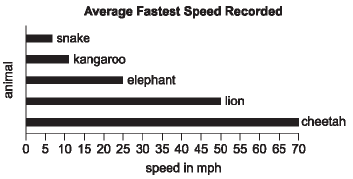These diagrams represent different stages of animal cell division....
The graph represents the average fastest speed of 5 animals recorded...
A student wants to determine whether temperature affects the rate at...
Which solution has the greatest concentration of hydroxide ions (OH-)?
What characteristic of early autotrophs gave them an advantage over...
Persons A and B have similar mRNA sequences with the exception of 1...
Two black guinea pigs bred and produced 3 black offspring and 2 albino...
When comparing 2 populations of animals, which statement most likely...
In humans, red-green color blindness is a recessive, sex-linked trait....
Which example best illustrates the process of natural selection?
Lydia works in a flower shop after school. She notices that the...
Paul and Simon want to determine who is more fit. They decide to run...
Megan examines a liver cell and observes an organelle with many...
Which process generates most of the ATP produced during cellular...
Scientists collected data on the height and weight of individuals in a...
A researcher counted the number of eggs a single fruit fly laid in 24...
Ella told her sister the sun would set at 6:30 p.m. and there would be...
The diagram shows a cell membrane composed of a phospholipid bilayer...
What occurs during metaphase I of meiosis?
Which example best illustrates Mendel's law of independent...
In humans, pigmented skin is dominant to non-pigmented skin...
What key factor distinguishes organic compounds from inorganic...
Which functional group found in amino acids is absent from...
Edison studies the effects of temperature on starch digestion in a...
While investigating yeast respiration, a researcher detects ethanol in...
Jeanine inherited 2 alleles for round eye shape and has round eye...
A science teacher performs an experiment to measure the CO2 uptake of...
Shown below is a growth curve for Paramecium grown in a 1.0 L...
How do enzymes speed up chemical reactions?
A scientist places a cell in a solution, and over time the cell gains...
The genotype of F1 individuals from a dihybrid cross is AaBb x AaBB....
...
Chan wants to determine how much the mass of fungus growing on a...
A scientist studies the effects that barnyard grass, a weed, has on...
Sunee and Jamila grow 2 distinct strains of E. coli bacteria following...
Most male crickets produce a mating song by rubbing together their...
Horse skeleton fossils indicate that the size of horses increased over...
What is the best definition of a scientific theory?
Ming is having trouble sleeping and decides to participate in a study...
Which experimental design would provide scientists with the best data...
Pepsin is a protein-digesting enzyme in the human stomach. Antacids...
Jenna's favorite breakfast food, papaya, contains significant...
Naomi adds cyclohexamide to cells grown in a test tube. Within...
During aerobic cellular respiration, where do ATP molecules form?
DNA and RNA have many structural similarities. Which structure in DNA...
The presence of which structure indicates that cells are NOT...
When the pH in a stomach increases from 2 to 4, how does the hydrogen...
The hydrolysis of which molecule provides energy for muscle...
The areobic and anaerobic pathways of cellular respiration REQUIRE...
How does the regulation of gene expression lead to cell...
















